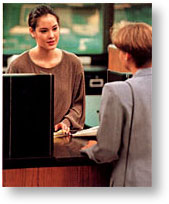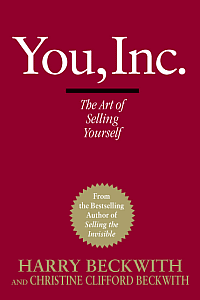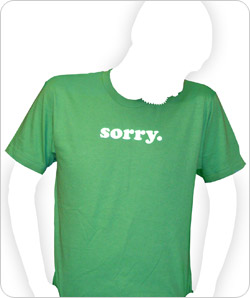 Let’s say a customer comes to you with a complaint.
Let’s say a customer comes to you with a complaint.
Maybe in person, via email or over the phone.
What’s the best approach?
It’s simple: SSTOP!
No, that wasn’t a typo. You read it right: SSTOP. And it represents a five-step process for approaching problems, diffusing anger, changing minds and winning the customer back. Let’s take a look.
 S is for SURPRISE.
S is for SURPRISE.
Psychologically, if you respond to a problem, complaint or accusation with surprise, three things happen. First, you begin to diffuse anger. Secondly, your reactive response comes off as natural and sincere. Lastly, the customer is more willing to forgive you.
PHRASES THAT PAYSES: “Really?”
Really is one of the most versatile words in the English language. It exudes both concern and curiosity. And based on the severity of the problem, changing the inflection of your voice indicates numerous emotions. For example, stop reading right now. Try saying the word really two times: first with a low pitch and second with a high pitch.
Two totally different meanings, right?
CUSTOMER: “Hi, this is Miss Jackson from room 2321. Um, I asked for a non-smoking room, but I think Joe Camel must have stayed here last night.”
YOU: “Really?”
OK. Great job. You’ve immediately displayed concern for the problem. Let’s move on to step two.
 S is for SORRY.
S is for SORRY.
Customers don’t want apologies, they want solutions. Still, saying you’re sorry never hurts. You still need to take ownership of the problem. And an effective technique for doing so is to combine “Sorry” with its polar opposite: thank you.
PHRASES THAT PAYSES: Sorry + Thank You.
CUSTOMER: “Hi, this is Miss Jackson from room 2321. Um, I asked for a non-smoking room, but I think Joe Camel must have stayed here last night.”
YOU: “Really? I’m sorry about that Miss Jackson, thanks for telling me.”
Good. You’ve showed surprise. You’ve thanked the customer. Now Miss Jackson is reassured that you’re on top of the problem. Let’s continue on.
 T is for THAT’S.
T is for THAT’S.
Step three is absolutely crucial. This is where you ensure the customer that her problem isn’t normal. That it’s an anomaly. And whatever happened to her is inconsistent with the type of service your company traditionally provides.
PHRASES THAT PAYSES: “That’s not normal,” “That’s horrible!” “That’s strange,” or, if possible, “In all the years I’ve been working here, that’s never happened!”
CUSTOMER: “Hi, this is Miss Jackson from room 2321. Um, I asked for a non-smoking room, but I think Joe Camel must have stayed here last night.”
YOU: “Really? I’m sorry about that Miss Jackson, thanks for telling me. You know, that’s not normal at my hotel.”
Excellent! You’ve showed surprise, thanked her, even taken ownership and reassured Miss Jackson that her problem isn’t the standard of service. Now it’s time to win her back.
 O is for OFFERING.
O is for OFFERING.
When I worked at the Ritz-Carlton, every employee was empowered up to $2000.
It was pretty amazing.
If a guest was so upset that an apology wouldn’t even scratch the surface, we had the power to offer them a free night (or weekend!) stay at our hotel. Sometimes the guest would be SO delighted at the offering, they’d actually come out better than if there hadn’t been a problem in the first place! (This is known as the Customer Recovery Paradox.)
PHRAES THAT PAYSES: Combine one of the following reassurance responders with your offering, “The best way for me to help you right now,” “Here’s what I can do,” (or if you want to have some fun), “You’re in luck!” “Well, I have good news for you!” “Today’s your lucky day!” or “Fortunately I work miracles!”
CUSTOMER: “Hi, this is Miss Jackson from room 2321. Um, I asked for a non-smoking room, but I think Joe Camel must have stayed here last night.”
YOU: “Really? I’m sorry about that Miss Jackson, thanks for telling me. You know, that’s not normal at my hotel. Fortunately, I work miracles!”
Perfect. You’re almost done SSTOPing this problem!
 P is for PROMISE.
P is for PROMISE.
The three most beautiful words of Approachable Service are PERSONALLY and RIGHT AWAY. Not someone else. Not your boss. YOU. And not “as soon as I can.” Not “as soon as possible.” RIGHT AWAY. As in, I promise to take care of this problem now.
CUSTOMER: “Hi, this is Miss Jackson from room 2321. Um, I asked for a non-smoking room, but I think Joe Camel must have stayed here last night.”
YOU: “Really? I’m sorry about that Miss Jackson, thanks for telling me. You know, that’s not normal at my hotel. Fortunately, I work miracles! And I will personally get you a new room right away.”
CUSTOMER: “Wow! Thanks for taking care of this problem quickly. That’s why I love this hotel. In fact, I am going to recommend that you be promoted to General Manager.”
Wow, GM? Look at you! Well done.
OK. Let’s do a quick review of SSTOP:
SURPRISE – respond as if the problem is news to you.
SORY – apology PLUS thank you.
THAT’S – inconsistent with your service.
OFFERING – to win them back.
PROMISE – to do it personally and right away.
Next time you need to approach a disappointed customer, remember these five steps, and you’ll be sure to SSTOP the problem!
LET ME ASK YA THIS…
What’s your approach to SSTOP customer complaints?
LET ME SUGGEST THIS…
Share it with us!
* * * *
Scott Ginsberg
Author/Speaker/That Guy with the Nametag
www.hellomynameisscott.com
add to del.icio.us * digg it! * email this post
 What three words do your customers NEVER want to hear?
What three words do your customers NEVER want to hear?
 The first words out of your mouth frame the entire customer experience.
The first words out of your mouth frame the entire customer experience. I read about three books a week.
I read about three books a week.
 Let’s say a customer comes to you with a complaint.
Let’s say a customer comes to you with a complaint. S is for SURPRISE.
S is for SURPRISE. S is for SORRY.
S is for SORRY.  T is for THAT’S.
T is for THAT’S.  O is for OFFERING.
O is for OFFERING.  P is for PROMISE.
P is for PROMISE.  Um, because it’s AWESOME, that’s why.
Um, because it’s AWESOME, that’s why. Little did I know that I would be doing staff training at the Minneapolis Hyatt one week after this happened:
Little did I know that I would be doing staff training at the Minneapolis Hyatt one week after this happened: Imagine you’re waiting in line at the airport.
Imagine you’re waiting in line at the airport. Typical O’Hare. Always causing delays in other cities.
Typical O’Hare. Always causing delays in other cities.